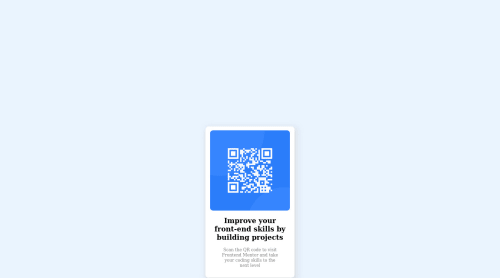I used CSS and HTML for creating a qr-code for windows and mobile

Solution retrospective
What is not good in my css for relative? Another better ways to accomplish it?
What did you find difficult while building the project? Which areas of your code are you unsure of? Do you have any questions about best practices?
Please log in to post a comment
Log in with GitHubCommunity feedback
- @MelvinAguilar
Hello there 👋. Good job on completing the challenge !
I have some suggestions about your code that might interest you.
Metadata 🗃️:
- The
langattribute is used to declare the language of the webpage. Add thelangattribute to the<html>tag with the valueen.
-
The
viewportmeta tag is missing. theviewportmeta tag is used to control the layout of the page on mobile devices. Add theviewportmeta tag to the<head>tag:<meta name="viewport" content="width=device-width, initial-scale=1.0">.You can check your solution on a mobile device to see how your solution is distorted by not using this tag. ⚠️
HTML 🏷️:
- Wrap the page's whole main content in the
<main>tag.
- Since this component involves scanning the QR code, the image is not a decoration, so it must have an
altattribute. Thealtattribute should explain its purpose. e.g.QR code to frontendmentor.io
CSS 🎨:
- To center an element vertically, you should use a height to its container. In this case it is recommended to use "min-height: 100vh" so that it occupies 100% of the viewport height. e.g.:
body { min-height: 100vh; }
- Setting the width of the component with a percentage or a viewport unit will behave strangely on mobile devices or large screens. You should use a max-width of
320pxor20remto make sure that the component will have a maximum width of320pxon any device, also remove thewidthproperty with a percentage value.
CSS Reset 🔄:
-
You should use a CSS reset. A CSS reset is a set of CSS rules that are applied to a webpage in order to remove the default styling of different browsers.
CSS resets that are widely used:
I hope you find it useful! 😄 Above all, the solution you submitted is great!
Happy coding!
Marked as helpful - The
Join our Discord community
Join thousands of Frontend Mentor community members taking the challenges, sharing resources, helping each other, and chatting about all things front-end!
Join our Discord